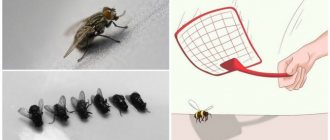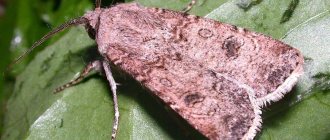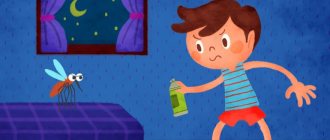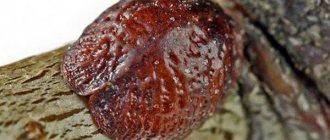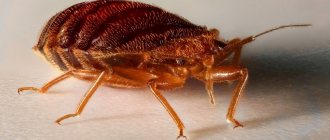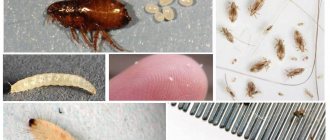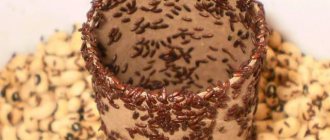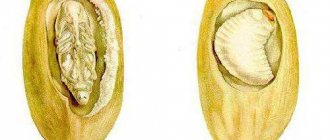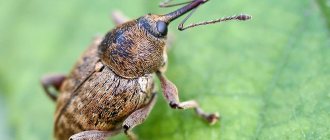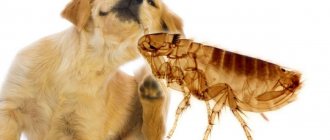Why is the pest dangerous?
The main danger of flies to humans is that the insects on their legs carry pathogens of infections and other diseases:
- bacterial;
- fungal;
- viral;
- parasitic;
- intestinal.
The greatest threat to humans is the risk of infection:
- tuberculosis;
- helminths;
- intestinal myiases;
- anthrax;
- dysentery;
- cholera;
- conjunctivitis;
- diphtheria.
On the body of one housefly there are up to 6 million microorganisms potentially dangerous to humans. And adult individuals are capable of laying almost 7 thousand eggs for food.
Stages of development
The green fly goes through the following stages in its development:
- Egg – 8-25 hours.
- Larva (maggot) – 10±3 days.
- Pupa 3-4 days.
- Adult – 45 days.
Carrion birds quickly find open wounds, dead birds, animals and lay eggs there on the very first day. But they can also be deposited in the damp soil of flowerpots, on rotten fruits and vegetables. The eggs look like white sticks 1 mm long. Development time depends on temperature and humidity.
After a day, small larvae (a little more than 1 mm) appear from them. They develop on a favorable basis - kitchen waste, feces, animal corpses. They have 1 mouth opening plus 2 respiratory openings. There is a black hook in the mouth with which they move.
The larvae constantly secrete juice through this hook, as if from a syringe, under pressure. Under the influence of fermented juice, the tissues quickly dissolve, forming a corpse broth on which the insect feeds. The larvae grow quickly, become thicker, larger, moving to pupation after 7-14 days, choosing warm, dry places.
The pupal stage (puparia) lasts 3 days. After hatching, the adults are ready to reproduce. Each female is capable of laying 100-150 pieces per day, repeating the process every 2 days. During its short life, 1 individual is capable of reproducing up to 700 eggs (6-8 clutches).
Some types of carrion flies can lay up to 2000 pieces in 1.5 months. During one warm period, several generations appear. In warm, indoor areas, insects can breed year-round. They overwinter in any phase except eggs.
Why is it difficult to kill a fly
It is difficult to catch the insect by surprise and swat it because of the insect’s unique vision: there are 5 eyes on the fly’s head: 2 main and 3 simple. Large volumetric eyes consist of 4 thousand facets and provide a 360-degree view.
The fly sees all objects in front and behind, above and below, to the right and left with three-dimensional eyes, so it will not be possible to sneak up from behind. With simple eyes, a fly examines objects close up, distinguishes small and medium-sized things well, and ignores large ones.
The insect processes 100 images per second at a speed 6 times faster than a human. The critical flicker frequency—the number of frames a fly sees per second—is 250 Hz. In humans, this indicator is only 60 Hz. Therefore, lightning-fast hand movements that people feel are seen by flies as a slow change of frames.
The only skill that a fly cannot master is the ability to distinguish the infrared spectrum. In the dark, the pest prefers to sleep in a secluded place where nothing threatens it.
This vision device saves insects from any danger, including the threat of physical harm from humans.
Buy electric traps
Have you ever wondered what repels flies in the courtyard of outdoor cafes? Owners of cafes and restaurants most often use electric insect traps. So why not use this fly repellent in the yard of a private home?
Such traps can be hung in the yard at night. Traps should be hung away from the dinner table; no one wants to see a dead fly in their soup. Also be careful with such devices if you have small children or pets in your home. An electric trap will not cause serious harm to a person or large animal, but it may cause pain.
Mechanical methods
Despite the fact that it is difficult to kill a fly, the mechanical method is often used and consists of using:
- Available materials: rolled up newspaper, slipper, heavy object. The insect is simply flattened by the force of a direct blow.
- Fly swatters. A special plastic device is a stick with a flat silicone or rubber plate at the end.
- Fly nets. It will not be possible to kill a fly with its help, but such an obstacle will not allow the pest to enter the house. It is better to install the mesh both on windows and ventilation holes.
- Adhesive tape. A paper or silicone strip impregnated with a fly-attracting composition is hung on eaves or door (window) openings. Insects land on the sticky surface with their paws and stick. Pests actually die from lack of food and water.
It’s easy to make an analogue of adhesive tape at home. To do this you will need a glass jar, 40 g of castor oil, 1 tbsp. l. honey and 60 g rosin. All ingredients are heated and spread on thick paper or cardboard with a brush. The finished device is placed in a place inaccessible to children and pets.
Expanse in a dung heap
Landfills, garbage dumps, and manure heaps are the favorite habitats of these insects. In the village, neighbors often have livestock in their yard - goats, sheep, chickens, and if there is also a farm nearby: oh, how many flying and biting creatures rush towards a person’s habitat - they can trample them! After a week's absence from the dacha, the window sills are covered with a black “carpet”.
People advise to escape from the invasion of flies by planting castor beans, walnuts and Amur nuts under the windows (flies do not like the smell of leaves). Fresh bouquets of tansy and wormwood are good to arrange in the room itself. Tansy, for example, contains an essential oil that contains camphor, which has insecticidal properties. The latter has long been used in the fight against moths: the substance causes paralysis of the insect’s motor system. But either its concentration is weak, or flies have now become more modified: these impudent ones “sneezed” at natural aromas.
Nowadays, many new remedies against winged carriers of dirt and germs have appeared on the market. And these are not only the usual aerosol sprays, but special gels, granules and varnishes.
Fly gel can even be used in the kitchen!
Gel
, for example, is convenient for use in kitchens and other areas where food is prepared. It does not smell, does not generate dust and does not emit harmful substances into the environment. Ventilation of the room is also not required, but it is worth placing the substrate in places where children and pets cannot reach it. The gel does not have a harmful effect on people who are hypersensitive to chemicals. Its effect lasts for three months until it dries out. It’s good to use before leaving the dacha: put it in your rooms, when you arrive, there are no flies!
Fly pellets are one of the “new products” in the chemical industry
Granules also work on this principle.
. They are also scattered on substrates: flies fly up to them, try them and die. If this “dragee” is diluted with water to the consistency of syrup, then the resulting composition can be applied with a brush to surfaces where flies often land (in corridors, on terraces - where children cannot reach).
Varnish "Mukhoyar"
Varnish
good for ventilation holes: cockroaches will not come running from the neighbors - the varnish strip will block their path. This composition is convenient for treating premises against flies in barns and other premises for keeping farm animals. The main thing is to apply the varnish on surfaces where they cannot be reached by the tongue of a cow, goat, or sheep.
Gels, granules and varnishes are sold mainly imported and are not cheap. Pay attention to a series of similar products under the “Mukhoyar” brand. These are domestic analogues that have identical recipes, they are affordable, as they are made here.
A smoke bomb will reach insects in places where humans cannot reach.
For barnyards, chicken coops there is also an effective smoke bomb
"Mukhoyar." Its smoke penetrates into all cracks and destroys not only flies, horseflies, strings, but also cockroaches, fleas, lice eaters, and feather mites living in the litter. The checker does not burn, but emits a high column of smoke: it rises to the ceiling and gradually diverges, descending and penetrating everywhere - into cracks, ventilation, hidden cavities. In garages, sheds, attics of bathhouses and basements, this method helps to get rid of not only flies, but also wasps: they do not have time to fly out and bite a person. Smoke bombs are not used in residential premises, because after it a complete wet cleaning of the room is required, and the wallpaper may be yellowed from the smoke.
There are different types of smoke bombs available for sale. From experience, those made with peat chips are very smoky, releasing a lot of flakes and soot. There are also those that spark strongly and can cause a fire. Don’t go after cheap prices, buy products from trusted manufacturers.
Chemicals
In the fight against buzzing pests, insecticide chemicals are most effective in the form of:
- Aerosols. To kill flies, it is recommended to use proven means: Dichlorvos and Chlorophos. However, when using them, be sure to use personal protective equipment for the respiratory system and mucous membranes, and thoroughly ventilate the premises. After disinfestation, the room is wet cleaned using a soda solution.
- Electronic fumigator. Raptor, Off, Moskitol and other manufacturers produce devices with plates and liquids that help destroy and repel pests. The main advantages of such products: long-term effect, absence of odor and instant results.
- Powders and granules. They are used to treat large rooms and are effective due to their immediate nerve-paralytic effect on insects.
- Melkov. The popular product Mashenka works not only with cockroaches: the product kills flies just as effectively. One chalk is enough to process 20–30 m2 of space.
All chemicals are used in accordance with the instructions, in acceptable concentrations. There should be no children, pets, pregnant or lactating women in the premises during treatment. It is prohibited to carry out disinfestation in unventilated rooms.
Preventive measures
In order not to run around the store looking for an effective remedy against flies, prevent their appearance. Preventive measures are very simple and do not require drastic action from you.
Follow these guidelines:
- with the onset of the warm season, place mosquito nets on the windows, and curtains or special nets for doorways on the entrance doors of a private house;
- Maintain cleanliness in the apartment, promptly throw out garbage, wash dishes, remove food from public access;
- in the barnyard, carefully clean the animal sheds, treat the manure with a solution of karbofos;
- place pots of geraniums on the windowsills;
- plant mint, tansy, elderberry, and myrtle in your garden plot.
If it is not possible to remove food from open access, cover food with special mosquito nets for food and prepared dishes.
When several individuals appear in the apartment, immediately begin fighting, rather than waiting for the females to lay larvae.
A huge number of methods have been invented to kill and repel flies. You can buy special substances or mechanical traps in a specialized store or resort to folk methods. The best option would be to use several methods in combination. To prevent the problem from appearing again, follow simple preventive measures.
Household substances
Household products not intended for such purposes are also suitable for fighting flies. Among them:
- Glass cleaning liquid. To kill a fly, it is enough to spray a product containing ammonia on the fly from a spray bottle 5-10 times. This number of sprays is enough to kill a single adult.
- Hair fixation spray. The same principle of spraying is applied, but most often 1-2 clicks on the bottle spray are enough to hit the target.
- Dishwashing liquid and vinegar. The mixture of these substances is poured into a jar, the neck of which is covered with cling film. Pests fly into the small hole left, but they can no longer get out and drown in the composition.
The category of household appliances with special purposes includes fly repellers using ultrasound. The devices operate on mains power and emit ultrasonic waves that are not perceptible to human hearing, but are unbearable for flies.
The opposite effect is used in electron traps that emit ultraviolet light. The flies fly to the source and end up on the grid, where they die from the current. For humans, such a device is harmless (current-carrying elements are isolated), but for flies and other flying insects it is fatal.
The most elegant way
A house, a dacha, an apartment are the most important places for our vacation. We try to make them cozy so that they can recuperate in a pleasant environment. With this in mind, new interesting “tricks” have been created in the fight against flies - stained glass interior stickers
series "Mukhoyar" from .
The set of interior stickers includes 4 stained glass stickers, made in two styles! The picture shows 2 sets - “Stained Glass” and “Baroque Lace”
They represent a picture with an insecticidal bait applied to its surface. The flies die a few minutes after contact with the “fake stained glass” without sticking. The sticker easily attaches to the glass; you just need to remove the special backing. It is best to place the “picture” in the upper corner of the window: flies often squat in this place. Cool idea, not annoying.
The effect on flies occurs over a long period of time – up to 2.5 months. The only point: if the windows are located on the bright sunny side, the duration of action of the insecticidal composition is reduced to two weeks. In order not to attract the child’s attention, you need to stick the “decoration” high up, out of reach.
The stickers are made using original artistic styles - stained glass patterns, baroque. The set includes 4 stickers; their area is much larger than the “butterflies”, “cats” and “flowers” of other competing manufacturers. Profitable and aesthetically pleasing!
Folk recipes
Using improvised means, it is easy to make formulations that are more effective than store-bought insecticides and repellents. The following homemade homemade recipes have stood the test of time:
- Mix black pepper with sugar syrup. These foods familiar to humans are real poison for flies.
- Saccharin. The product is toxic to insects. To get rid of flies, you need to soak the newspaper in a mixture of saccharin and water and let it dry. Dropping 2-3 drops of water onto the paper activates the trap, which kills flies in a few hours.
- A mixture of tansy, castor oil and rosin. Natural repellent plants, together with a strong-smelling substance, leave insects no chance.
- A solution of 1 part formaldehyde and 3 parts milk in sweet water has a detrimental effect on flies. The composition is coated on door frames, the surfaces of window sills, and baits are made from bread crumbs.
- Beer. An open plastic bottle with a foamy drink is the simplest bait and trap in one form. Attracted by the aroma of hops and malt, the flies get inside, but cannot get out on their own.
A popular home ornamental plant, the Venus flytrap, will also be a faithful helper against flies. It is a natural predator of the plant world that feeds on flies and other flying insects.
It is quite difficult to kill flying insects with your own hands, but with the use of chemicals, traps and folk remedies it is quite possible. In addition to the fact that flies bother you with their buzzing, pests carry harmful microorganisms, bacteria and infections on their legs. That’s why it’s so important to get rid of insects in your home in a timely manner.
Varieties of small midges
Small midges that occupy houses and apartments are divided into several types. Each of them has its own favorite habitat, so small insects can be found in different parts of the home.
In kitchens
Drosophila, fruit flies or fruit flies prefer to live closer to food. More often, they or their larvae enter the house along with overripe, damaged fruit. However, there is another way to get to know insects. A piece of fruit left in a warm place for several days will certainly turn into a convenient place of residence for tiny “freeloaders.”
In indoor plants
Another type of winged invaders “thrive” in them. These are sciarids (soil or fungus gnats) that have chosen indoor plants as their habitat. The most popular culprit for the appearance of this type of midge is tea leaves, which many owners use to water flowers. Constantly waterlogged soil is another factor favorable to insects.
Drosophila and sciarids are absolutely harmless creatures that irritate only by their flickering. But there is another type of midge that is extremely dangerous for plants. These are whiteflies (aleurodids). Fortunately, you can even notice such “whites” with the naked eye.
